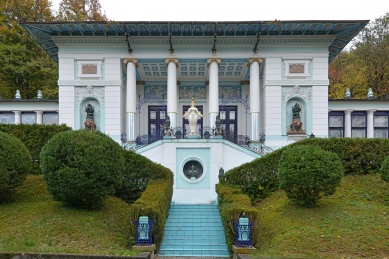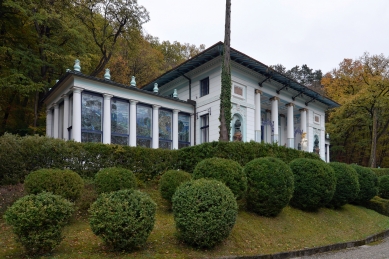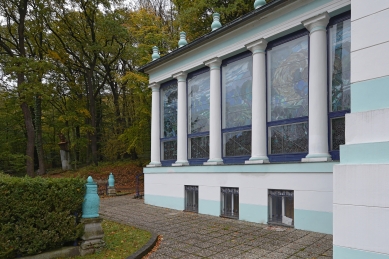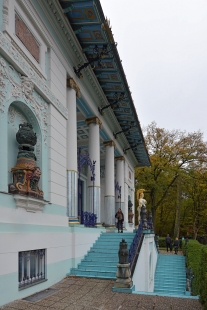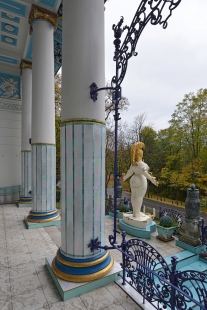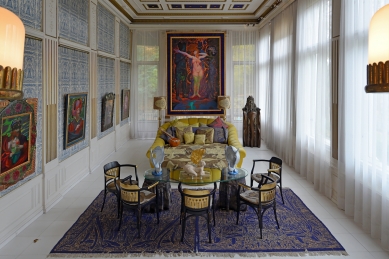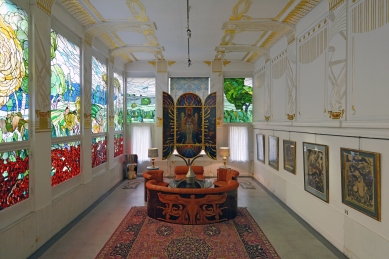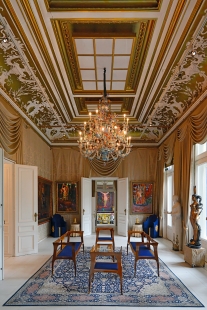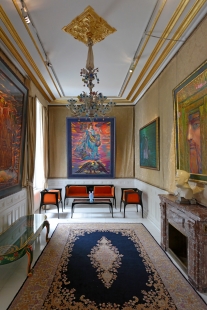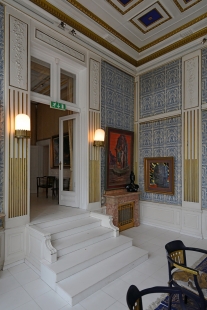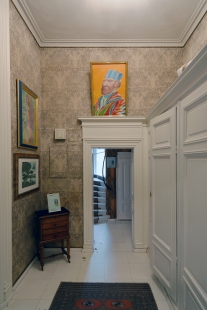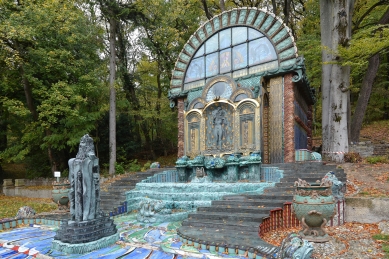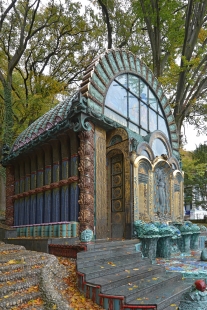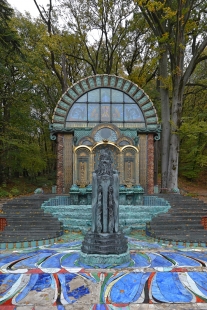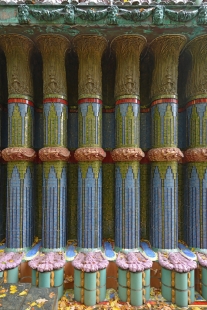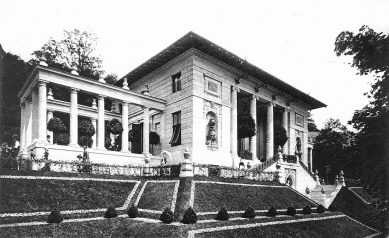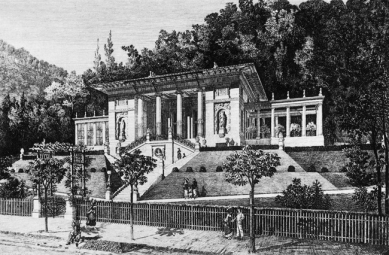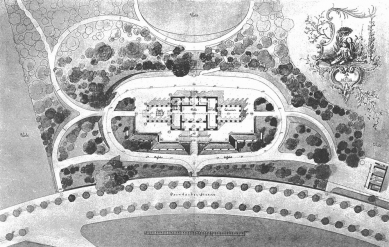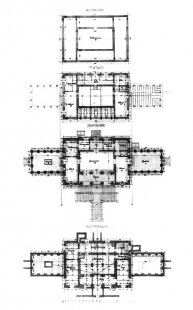
First private Wagner villa
Villa Wagner I, Ben-Tieber Villa, Ernst Fuchs Villa

The first villa that then forty-seven-year-old Otto Wagner built in his native Penzing was created at the end of the penultimate historicizing century and bears clear neo-Renaissance elements. The opulent summer palace in the western Viennese suburbs hints at Wagner's fondness for Palladian Renaissance villas.
The two-story house for the artist and his family was built on a gentle slope above the road and is accessed via an axially symmetrical projecting staircase. To the main body of the house, capped with a massive cornice, lower side wings serving as an open orangery are attached on both sides. As early as 1895, the southern wing was simply glazed and transformed into a billiard room. In 1900, the glazing of the northern wing followed, where stained glass windows by the co-founder of the Vienna Secession movement, Adolf Michael Boehm, were used in the spirit of the new era. Until 1911, the villa served for representative purposes, where Otto Wagner hosted receptions and festivals attended by the highest cultural, commercial, and political circles of Vienna. In August 1911, the villa was purchased by Bernhard Tieber, who was then the director of one of the most popular Viennese variety theaters, the Apollo-Theater. The wealthy merchant ensured that a rich social life continued to prevail in the villa.
During World War II, the villa was expropriated from Tieber's descendants and converted into the office of the Reichsstatthalter Baldur von Schirach. After the war, the villa became the property of speculators, and its demolition was even considered. The last of the conspicuous owners of the villa was the extravagant artist Ernst Fuchs (he was married three times and fathered a total of sixteen offspring with seven women), who purchased the considerably dilapidated house in 1972 and made a significant contribution to the transformation of the entire house and the adjacent park garden with his own painting and sculptural decoration. Fuchs originally planned to carry out the reconstruction with his artistic friends Friedensreich Hundertwasser and Arnulf Rainer, but eventually managed to realize everything himself, even though it took many years and cost a fortune. The villa originally served as a studio, but in 1988 he opened it to the public as a private museum. In 1996, Ernst Fuchs completed Nymphäum Omega in the garden, which is a Mannerist gazebo with a fountain and a well adorned with ceramic mosaics and glass stained glass.
However, the second villa that Wagner completed a quarter-century later in 1913 on the adjacent northern plot deserves far more attention than Fuchs' fountain. In a significantly smaller and distinctly more modern villa equipped only with geometric decor, Wagner ultimately spent just three years, as he sold the house immediately after the death of his younger wife. Nevertheless, through this austere building, Wagner clearly communicated to the public that he still determined the direction of pre-war Viennese architecture.
The two-story house for the artist and his family was built on a gentle slope above the road and is accessed via an axially symmetrical projecting staircase. To the main body of the house, capped with a massive cornice, lower side wings serving as an open orangery are attached on both sides. As early as 1895, the southern wing was simply glazed and transformed into a billiard room. In 1900, the glazing of the northern wing followed, where stained glass windows by the co-founder of the Vienna Secession movement, Adolf Michael Boehm, were used in the spirit of the new era. Until 1911, the villa served for representative purposes, where Otto Wagner hosted receptions and festivals attended by the highest cultural, commercial, and political circles of Vienna. In August 1911, the villa was purchased by Bernhard Tieber, who was then the director of one of the most popular Viennese variety theaters, the Apollo-Theater. The wealthy merchant ensured that a rich social life continued to prevail in the villa.
During World War II, the villa was expropriated from Tieber's descendants and converted into the office of the Reichsstatthalter Baldur von Schirach. After the war, the villa became the property of speculators, and its demolition was even considered. The last of the conspicuous owners of the villa was the extravagant artist Ernst Fuchs (he was married three times and fathered a total of sixteen offspring with seven women), who purchased the considerably dilapidated house in 1972 and made a significant contribution to the transformation of the entire house and the adjacent park garden with his own painting and sculptural decoration. Fuchs originally planned to carry out the reconstruction with his artistic friends Friedensreich Hundertwasser and Arnulf Rainer, but eventually managed to realize everything himself, even though it took many years and cost a fortune. The villa originally served as a studio, but in 1988 he opened it to the public as a private museum. In 1996, Ernst Fuchs completed Nymphäum Omega in the garden, which is a Mannerist gazebo with a fountain and a well adorned with ceramic mosaics and glass stained glass.
However, the second villa that Wagner completed a quarter-century later in 1913 on the adjacent northern plot deserves far more attention than Fuchs' fountain. In a significantly smaller and distinctly more modern villa equipped only with geometric decor, Wagner ultimately spent just three years, as he sold the house immediately after the death of his younger wife. Nevertheless, through this austere building, Wagner clearly communicated to the public that he still determined the direction of pre-war Viennese architecture.
The English translation is powered by AI tool. Switch to Czech to view the original text source.
3 comments
add comment
Subject
Author
Date
Výzdoba neúměrně bohatá v poměru k užitku z bydlení
17.10.19 12:30
to není výzdoba, to je kýč
Dominika Šišková
17.10.19 06:18
Re: kýč
redakce
18.10.19 10:51
show all comments





